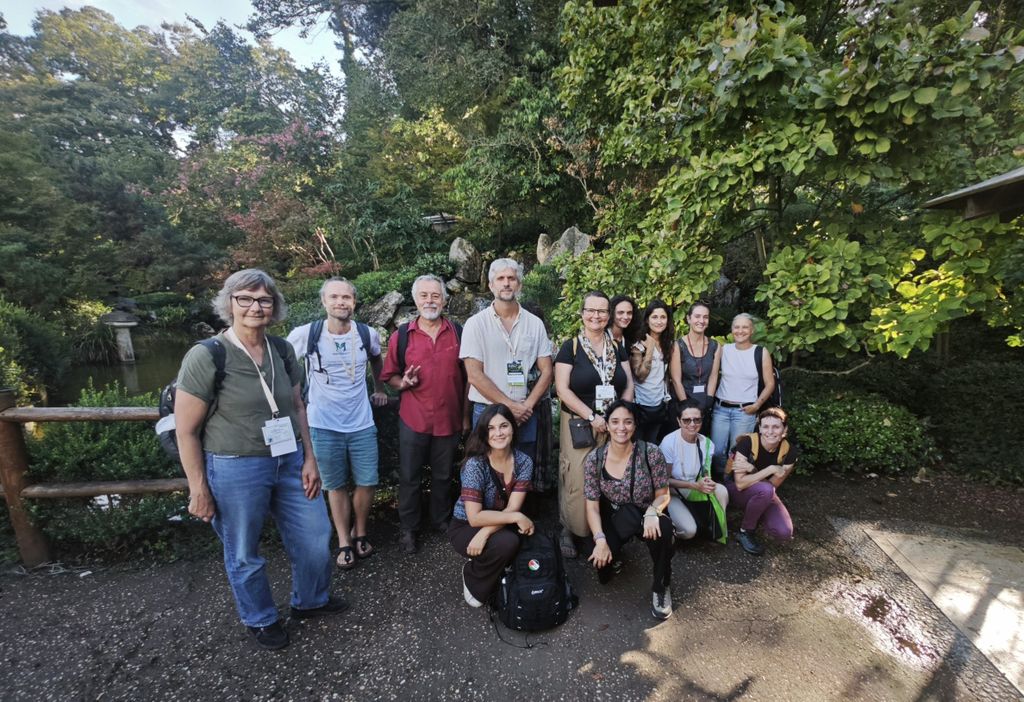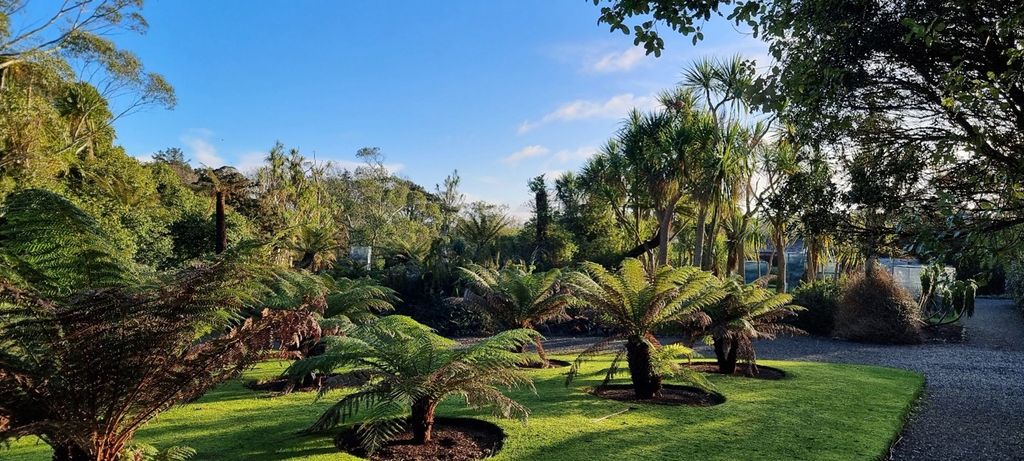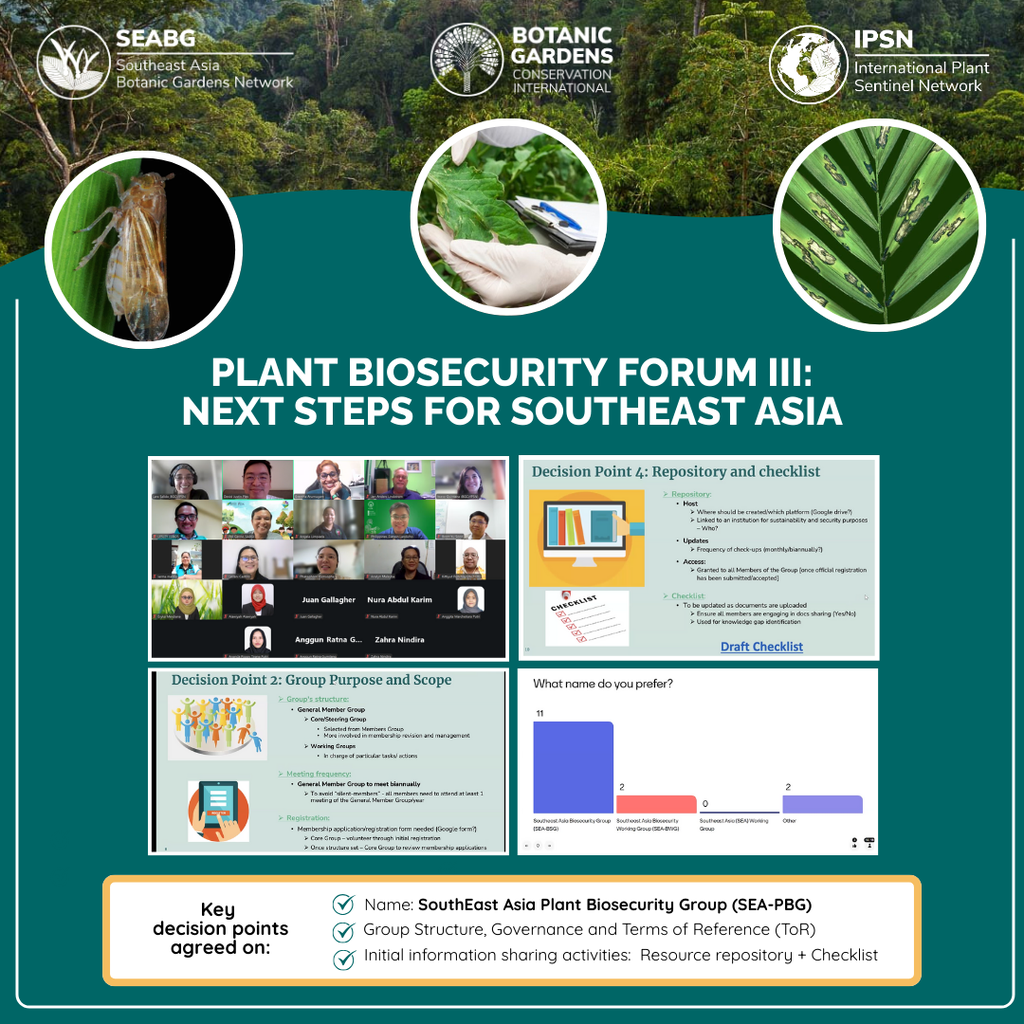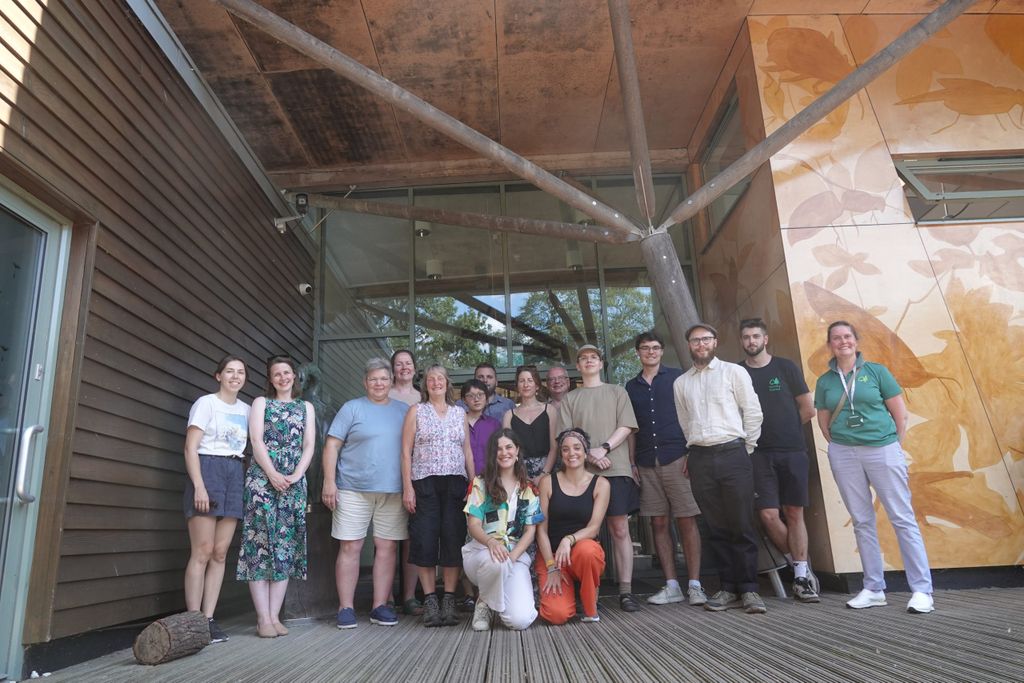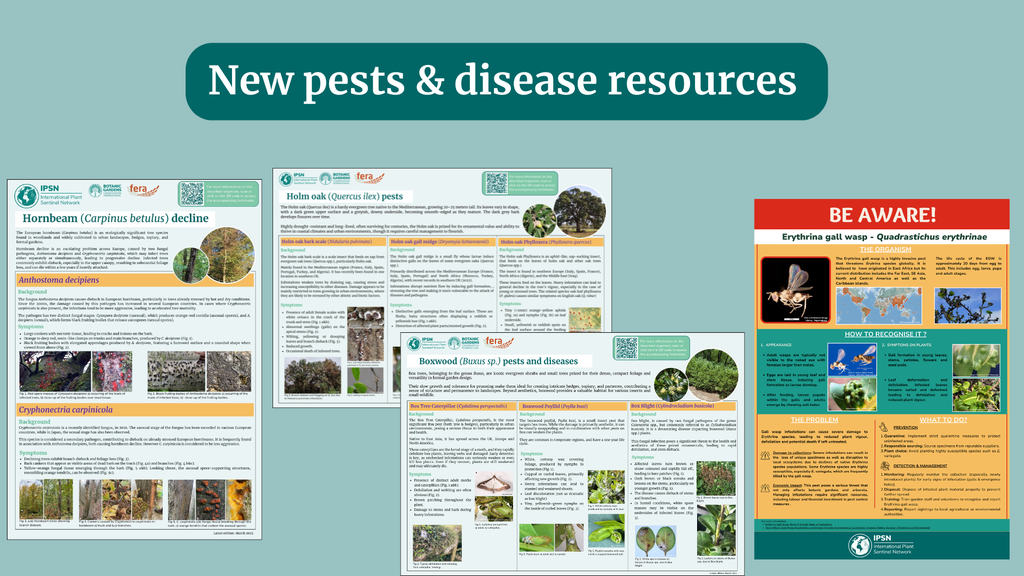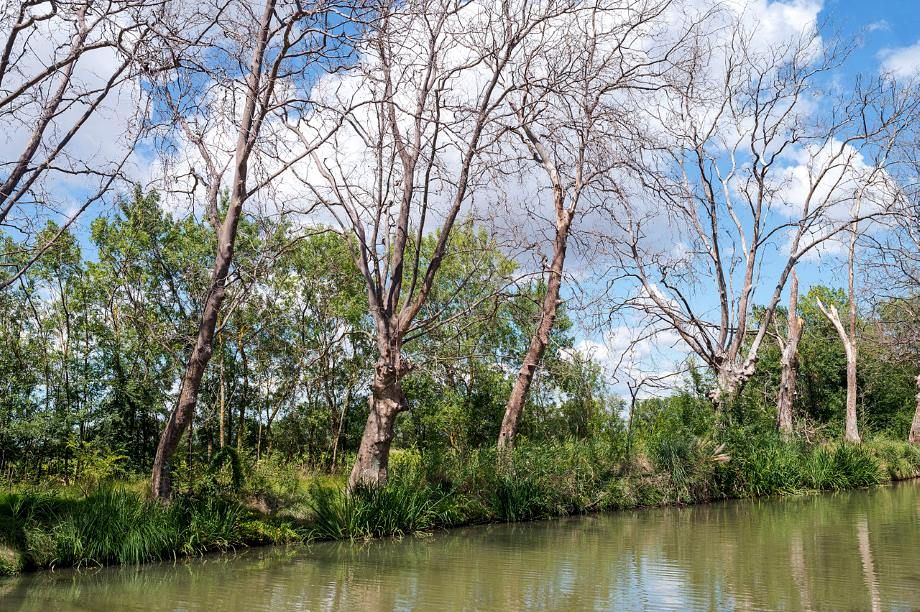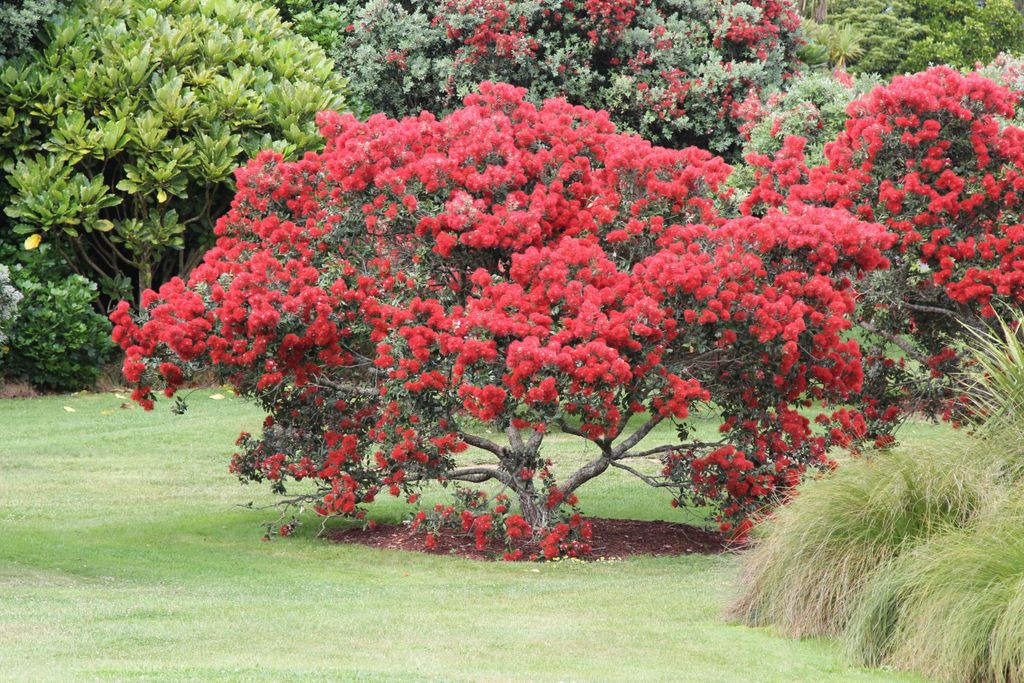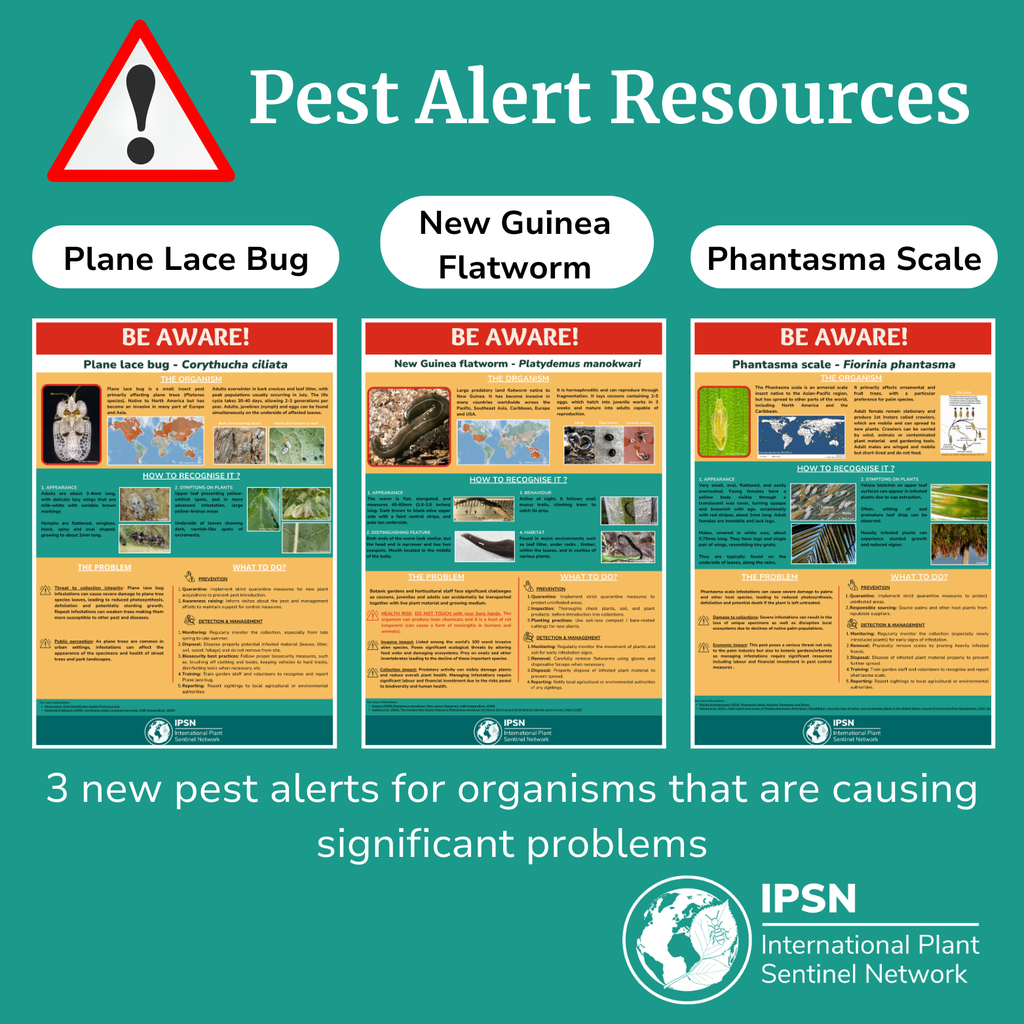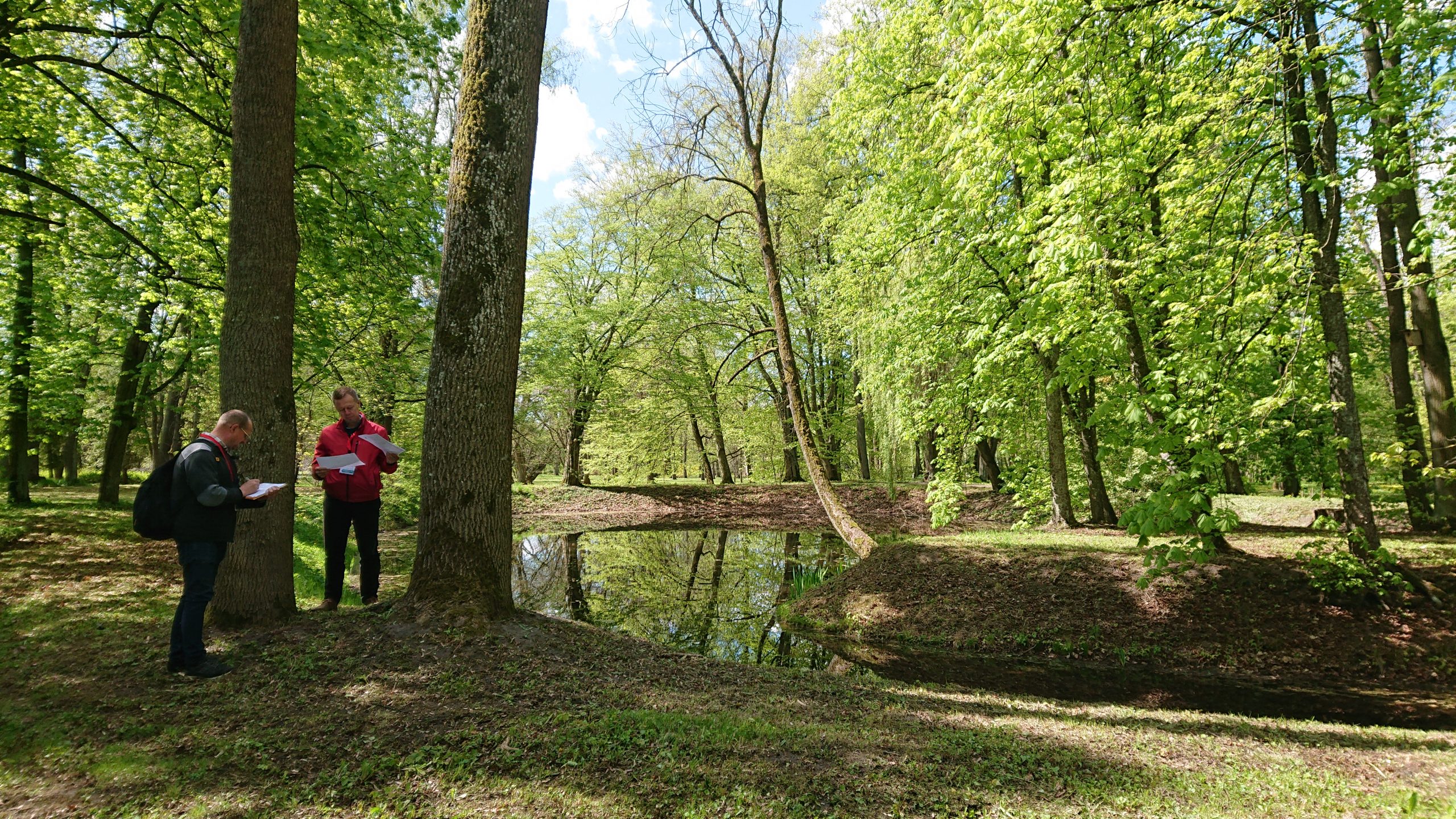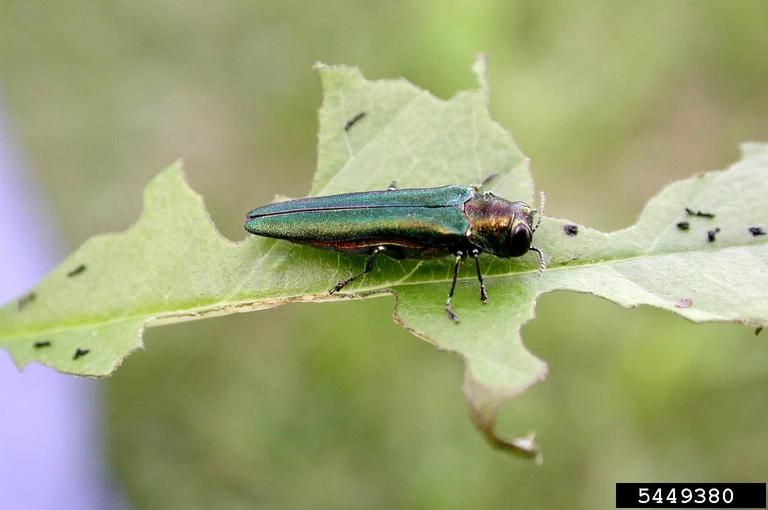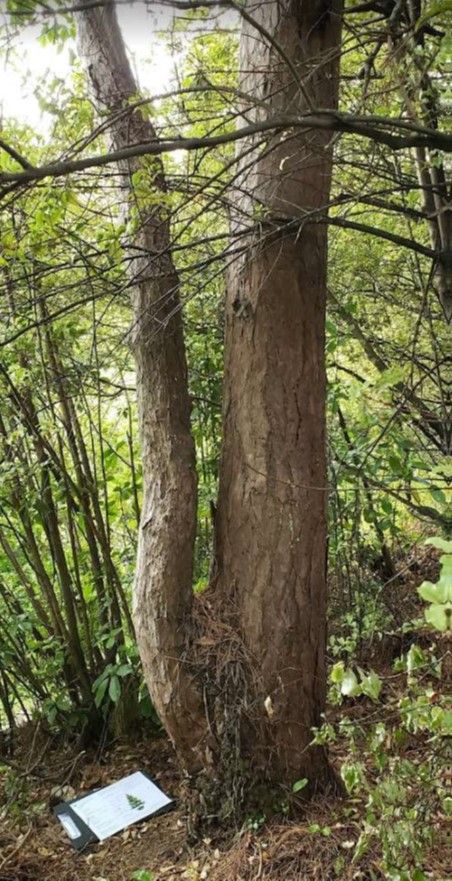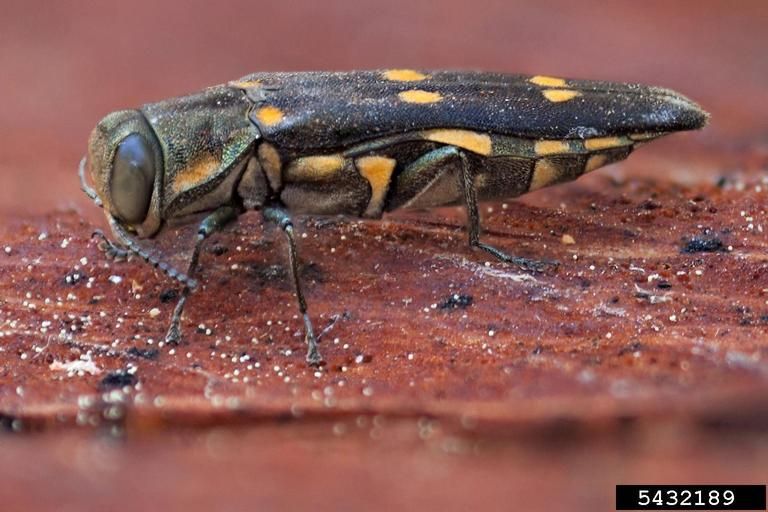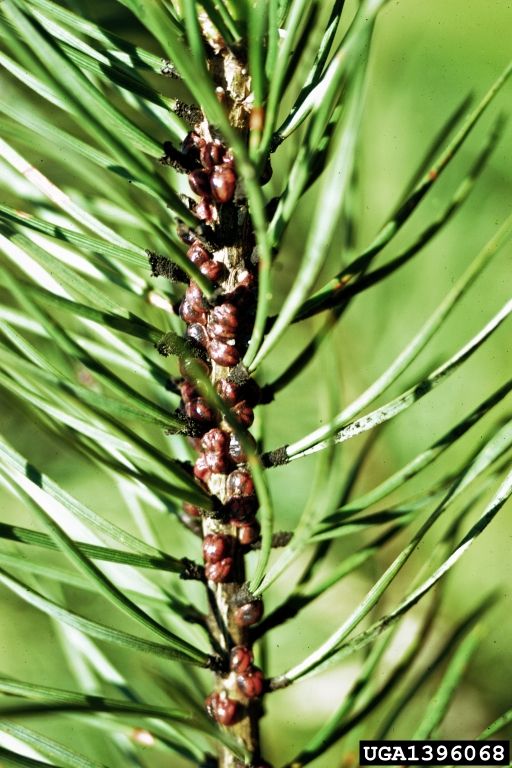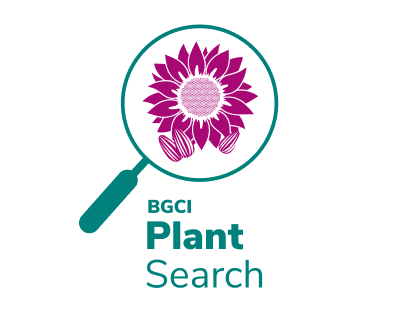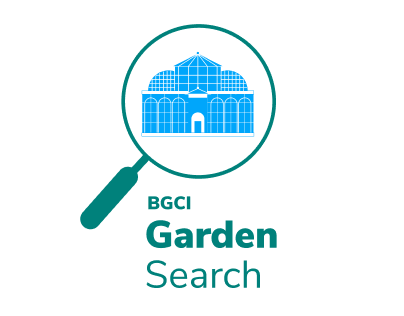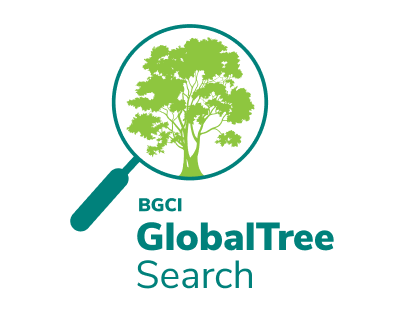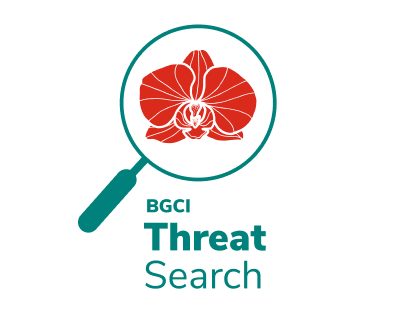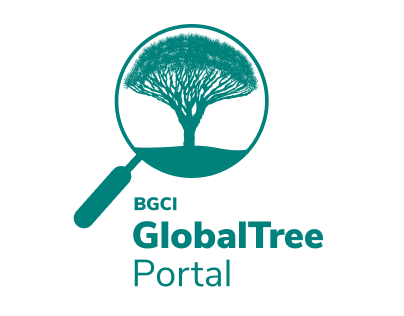International Plant Sentinel Network
Acting as an early warning system to recognise new and emerging pest and pathogen risks
- About
- Sentinel Plants and Living Collections
- Biosecurity
- Projects and Initiatives
- Join the IPSN
- Get involved
- Resources
Welcome to the International Plant Sentinel Network (IPSN), a global initiative dedicated to safeguarding plant health and promote plant biosecurity worldwide.
Established in 2013, the IPSN is a collaborative network bringing together botanic gardens/arboreta, research institutions, National Plant Protection Organisations (NPPOs) and plant health experts worldwide. Coordinated by Botanic Gardens Conservation International (BGCI), the IPSN aims at providing a vital early warning system, identifying and sharing information about new and emerging pest and pathogen risks.
Our mission encompasses several key objectives:
- Coordinating and facilitating international plant health surveillance efforts efforts.
- Raising awareness about plant biosecurity and promoting best practices.
- Building capacity through development of information resources and delivery of in person and online courses.
- Fostering collaboration among diverse stakeholders to safeguard plant species from pests and diseases.
Working together with our members and partner organisations we advocate for the utilization of living collections as invaluable resources for pest and pathogen understanding, monitoring and research. Equally striving to enhance biosecurity awareness through education and outreach activities.
Learn more about the IPSN and hear from our partners and collaborator’s experiences here:
You can also read more about the IPSN journey and current activities by visiting our page about the IPSN History:
Explore our website to learn more about our projects, initiatives and resources as well as how to become a member.
Come and join us in our commitment to protect plant health and biodiversity worldwide!
IPSN News & Events
SEE MOREIntroduced organisms can have large ecological and economic impacts on their new ranges and the native species that inhabit them. This is never more so true than with plant pests and pathogens. One reason for the high levels of damage seen is that plants, having not evolved alongside these introduced species, have built up no natural resistance. Similarly, it is unlikely that any natural predators will be present to control population sizes. Identifying potential threats to native flora before an organism is introduced can drastically improve the chances of eradication or control/containment programmes, or even better can stop their introduction in the first place. This is where sentinel plants can provide unique benefits to plant health.
Sentinel Research
Plant species maintained outside of their natural ranges (e.g. as in botanic gardens and arboreta) offer a unique opportunity to understand and predict potential threats to a country’s plant health by acting as standing sentinels in foreign lands.
These sentinels plants held in botanic gardens and arboreta can be monitored for damage by local pests and diseases that, although native to their current location, are not yet found in the host’s country of origin. This information can then be used to provide an early warning system and can aid plant protection efforts at a regulatory level (for example within Pest Risk Analysis).
Sentinel plants can also provide valuable information which can help:
- Increase understanding about ‘known’ pests and diseases (e.g. dispersal mechanisms, origin, etc.)
- Identify new pest-host associations (e.g. suggest which species of plant may be particularly susceptible/ resistant to a particular pest)
- Identify potential biocontrols
Previous Research
A number of previous studies using sentinel plants in botanic gardens and arboreta illustrate their potential in informing plant health:
- ISEFOR – Increasing Sustainability of European Forests: Modelling for security against invasive pests and pathogens under climate change
- PRATIQUE – Enhancements of Pest Risk Analysis Techniques
- The New Zealand Expats Plant Project
In the spring of 2011 BGCI carried out an electronic survey to learn more about the relevant expertise and policies already in place at botanical institutions around the world. Results revealed a solid foundation of expertise, resources, partnerships and practices that aid in understanding and addressing invasive species problems at individual institutions. However, it also identified a need for more formal or regular training and enhanced communication and coordination among institutions in order to increase the power and impact of the network.
Read more about the 2011 survey below.
The Role of Living Collections
Botanic gardens and arboreta are valuable scientific resources and as a result have become leading authorities in plant conservation, championing projects and contributing to research in the area. The IPSN is an opportunity for gardens to continue this work and contribute on an international scale to the safeguarding of plants from pests and pathogens.
Living Collections
It is estimated that 30-40% of known plant species are grown in living collections of the more than 3,000 botanic gardens and arboreta throughout the world. Often, species are maintained in gardens not in the country or even on the continent in which they are native. These expatriate plants can act as standing sentinels for potentially invasive pests and pathogens. For example, surveying native European plants growing in botanic gardens and arboreta outside Europe, especially in countries with similar climates, offers a unique opportunity to monitor for damage by non-native pests and diseases. This information can then be used to provide an early warning system by informing plant protection efforts such as Pest Risk Analysis (PRA); identifying new pest and pathogen risks to a country’s native flora.
Horticultural Expertise
Horticultural staff working within gardens have unique and key skills to offer sentinel research. Not only do they have a wealth of knowledge of the plant species they work with, they are familiar with individuals within plant collections. Specifically staff have an understanding of, or are able to access information detailing, the history of the plant including its origin, general health, management issues, surrounding environment, climate, recent weather etc. This knowledge can provide key clues to the cause of any deterioration of health in a plant; potentially revealing or ruling out abiotic causes.
Further to this, due to their familiarity with collections, horticultural staff are likely to be able to recognise changes in a plant’s health. However most importantly, they will not only be able to understand the cause but also be able to recognise when damage is out of the ordinary and should potentially be investigated and escalated.
Find out how your garden can become a member of the IPSN and contribute to safeguarding global plant health in the ‘Join the IPSN‘ section above.
Publications of Interest
Britton, K. O., White, P., Kramer, A., & Hudler, G. (2010). A new approach to stopping the spread of invasive insects and pathogens: early detection and rapid response via a global network of sentinel plantings
Kramer, A. (2010, June). Using BGCI’s databases to connect plant collections and expertise to support the development of an International Sentinel Plant Network. In Proceedings of the the 4th Global Botanic Gardens Congress, Dublin (pp. 14-18).
Kramer, A., & Hird, A. (2011). Building an international sentinel plant network. BG Journal, 8(2), 3-6.
Roques, A., Fan, J. T., Courtial, B., Zhang, Y. Z., Yart, A., Auger-Rozenberg, M. A., … & Sun, J. H. (2015). Planting sentinel European trees in eastern Asia as a novel method to identify potential insect pest invaders. PloS one, 10(5), e0120864.
In an interconnected world, where the movement of plants and plant products is ubiquitous, international cooperation is essential to prevent the spread of pests and diseases that threaten plant health and biodiversity. Biosecurity is a fundamental aspect of botanic garden living collections management and essential for preserving plant diversity and protecting ecosystems. By implementing robust biosecurity policies and best practices, botanic gardens can effectively manage risks and contribute to global efforts in plant conservation.
Plant Biosecurity
Plant biosecurity encompasses measures designed to prevent, control, and manage the risks posed by different organisms to plants and ecosystems.
Globally, the International Plant Protection Convention (IPPC) provides a framework for harmonizing phytosanitary measures and promoting cooperation among countries to prevent the introduction and spread of pests and diseases harmful to plant health.
The IPPC is a multilateral treaty aimed at protecting plant health while facilitating safe trade in plants and plant products (you can find more about the IPPC following the link below).
The IPPC develops International Standards for Phytosanitary Measures (ISPMs) that establish guidelines and best practices for plant health protection. These standards cover various aspects of biosecurity, including quarantine measures and inspection procedures, which are applicable to the management of plant collections in botanic gardens. To learn more about the ISPMs follow the link below:
International trade in plants and plant products is regulated through phytosanitary certification, which verifies compliance with phytosanitary requirements to prevent the spread of pests and diseases. Botanic gardens may require phytosanitary certification when exchanging plant materials with other institutions or participating in collaborative conservation projects.
You can learn more about the phytosanitary certification system by following the link below.
In an effort to facilitate the implementation and integration of the above standards and IPPC phytosanitary measures, BGCI has developed and currently offers a Biosecurity compliance certification.
This certification, sets a baseline standard for biosecurity and phytosanitary practices in institutions managing plant collections. It addresses all the key biosecurity policy and best practices elements and assesses compliance with key national/international plant material movement procedures.
To learn more about how to apply follow the link below.
Key Biosecurity Measures Relevant to Botanic Gardens
As custodians of diverse plant collections botanic gardens and arboreta are subject to the biosecurity provisions outlined by the IPPC. Some of these essential biosecurity measures and procedures include:
- Pathway Risk Analysis (PRA): This is a crucial activity for botanic gardens to assess and manage the risks associated with introducing and moving plants and plant material into and within their collections. It involves identifying potential routes of pests and diseases introduction, evaluating their impacts, and implementing measures to prevent their spread. This process safeguards plant collections, protects ecosystems, and ensures sustainability by enabling targeted control and monitoring efforts.
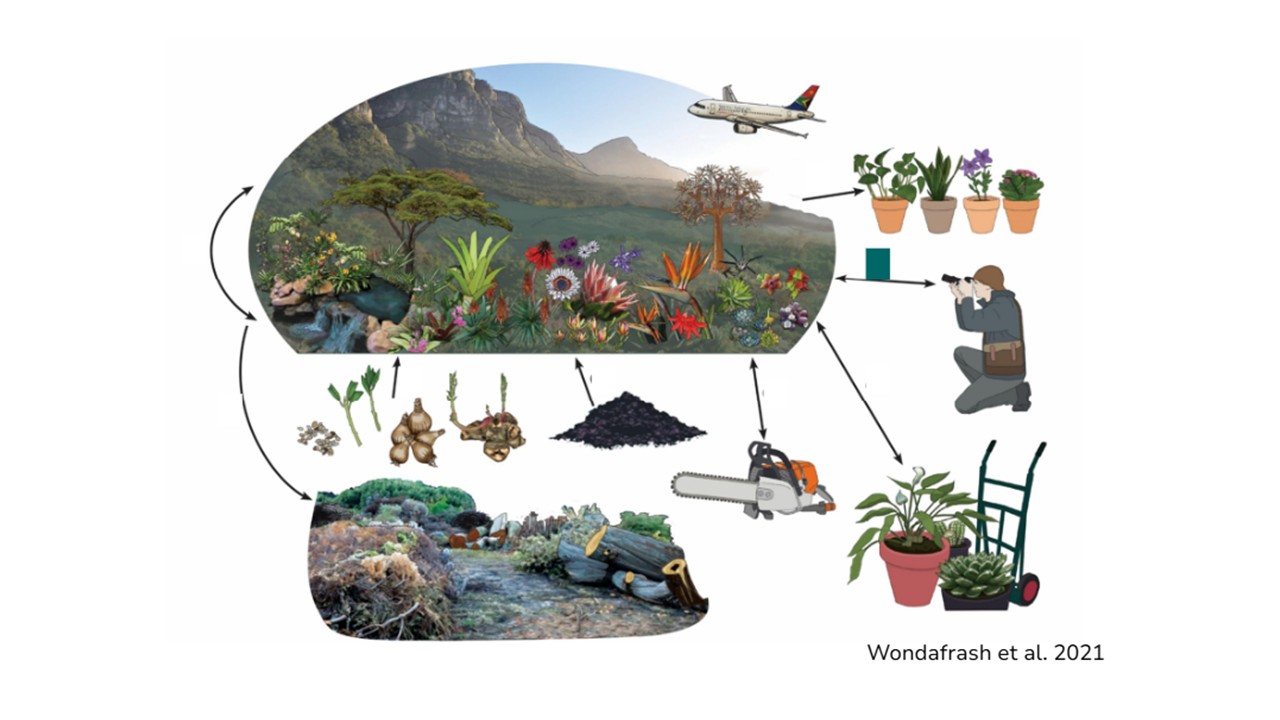
- Development and Implementation of Biosecurity Policies and Best Practices Guidelines: Both documents are fundamental for plant collection management as they provide a structured approach to safeguarding valuable and often rare collections, ensuring compliance with national and international regulations, and helping maintain the health of both the collections and the wider environment. While Biosecurity Policies are formal documents outlining the rules and procedures designed to prevent the introduction and spread of harmful pests, pathogens, and invasive species within and beyond the collection. Biosecurity best practices are the practical steps and protocols that focus on implementing these policies on a day-to-day basis (e.g. including information such as use of quarantine areas, cleaning of tools and footwear, and proper waste disposal). Clear policies and best practice protocols are vital for protecting rare collections, complying with regulations, and minimizing biosecurity risks in these high plant/people-traffic environments.
- Surveillance and Early Detection: Timely detection of pests and diseases is essential for effective biosecurity.Surveillance in living plant collection management should include regular monitoring, thorough documentation, and standardized protocols for detecting pests, diseases, or other threats. Accurate record-keeping and the use of digital tools help ensure timely detection and effective response, safeguarding the health and integrity of collections. Botanic gardens can also contribute to international efforts in surveillance and early detection by monitoring their plant collections, participating in international initiatives and reporting relevant information to national authorities (find your National Plant Protection Organization HERE).
.
The IPSN and Plant Biosecurity
The IPSN is dedicated to promoting biosecurity and building capacity and awareness among botanic gardens, arboreta and other plant collection organisation and users worldwide.
Through its resource development and collaborative efforts, IPSN empowers its members to proactively monitor/manage pest and disease risks, protect plant collections, and contribute to global plant conservation efforts.
You can learn more about current efforts by visiting our project and resource pages.
The IPSN is carrying out a number of funded projects supported by the UK (through DEFRA – Department for Environment, Food and Rural Affairs), the European Union (Horizon Europe programme) and the US (through USFS-USAID – US Forest Service/US Agency for International Development).
General surveillance projects
These are focused on the monitoring of key host species for pests and pathogens to identify novel or unusual species that could potentially affect the native species if introduced to their native ranges.
Targeted Surveys
The IPSN carries out a number of surveys to monitor the spread and distribution of particular pests and diseases of interest. These are all on-going and are open to any interested botanic garden/arboreta to join in. Survey forms and identification resources are available to support each survey, as well as guidance documents to aid in the identification of symptoms. Any interested gardens are encouraged to get in touch with the IPSN coordinator and request further information about how to become members of the IPSN network and actively participate in the existing surveys.
IPSN Network
We currently count with more than 100 botanic gardens and arboreta as part of the IPSN network.
You can find a list with our current members by following this link.
If your garden is not listed but you would like it to be, please email the IPSN project officer Itxaso Quintana.
Benefits for Member Gardens
The IPSN provides a number of benefits to member gardens including:
- Increased support for monitoring and facilitating access to diagnostic expertise to allow for quick identification of any damaging organisms.
- Regular communication and sharing of information related to biosecurity and key organisms of concern.
- Opportunities for cross-collaboration and personal skill development through online and in-person workshops.
- Provision of standardised protocols and surveillance tools.
- Being part of the prioritisation process for future programmes and initiatives.
- Encouragement and promotion of the use of living collections in plant health and biosecurity research and awareness.
We would like to hear from any botanic gardens and arboreta that already carry out work relating to plant pests and pathogens and/or wish to build their capability to do so.
How to join
To join the network, please follow these steps:
1. Read and agree to the IPSN’s IPSN Member Gardens Agreement (available in English, French and Spanish)
2. Designate a contact person within your organisation who will interact with the network coordinator and ultimately help to coordinate IPSN activities.
3. Send an email to the IPSN project officer confirming your garden’s interest in joining the network and the contact details of your designated IPSN contact person at itxaso.quintana@bgci.org.
If you are from a plant health institute or a National Plant Protection Organisation (NPPO) and are interested in becoming involved in any initiative and/or project, we would also like to hear from you. Please contact our Plant Health Manager Lara Salido.
How to get involved in our work
We are always looking to engage with more partners to enhance, support and amplify work related to plant health and biosecurity. We welcome queries from interested botanic gardens/arboreta, research institutes, NPPOs, etc..to:
-
-
- Participate in our targeted surveys,
- Trial monitoring methodologies,
- Use our training materials [see Resources section],
- Contribute to our databases and forums,
- Help us identify examples of best practice
- and generally provide feedback in order to help shape and guide the network.
If this is something that might interest your organisation, please do not hesitate to get in touch with our Plant Health Manager to discuss how you would like to engage with the IPSN.
To learn more about our current projects, please visit our “Project and Initiatives” page or if you would like to learn more about other ways to engage with our network continue reading below.
Ongoing Activities
Targeted surveys
Pine Tortoise Scale
Rose rosette virus
Oak Borers
Japanese beetle,
Beech Leaf Disease/Petrakia leafspot
Emerald Ash Borer/Ash dieback
General Plant Health Surveillance (through Plant Health Checker)
Promote the use of the PHC and ePHC to carry out general plant health surveillance and share information of P&D as well as how to best improve data sharing between institutions and nations.
Training materials
Promote sharing of resources and development of new materials/resources that could be share more widely within the BG&A community/public awareness.
Biosecurity Best Practices
Promote sharing of documentation related to best practices in botanic gardens, examples of policies, how to develop different facilities peer-based learning for collection management.
-
The IPSN has developed a number of resources to aid plant health and biosecurity activities in botanic gardens and arboreta. Including:
- Plant Health monitoring tools
- Pest & Disease diagnostic guides
- Informative posters
- Monitoring protocols
- and much more
For more information, please check the following sections and links to access the relevant documentation.
Plant Health Monitoring Tools
The Plant health Checker (PHC) has been developed by the IPSN and Fera Ltd, to help assess damage in plants with unidentified pests and disease problems. This monitoring tool aids users to survey, record damage, and generally assess health problems observed in the target plant species.
The PHC is a standardized 2-step surveying form available for deciduous and coniferous trees and non-woody plants.
To access more in-depth information about the PHC and how to access its electronic version (the ePHC), please click on the link below.
Pests & Diseases information resources
Organism Alert Posters
The IPSN has created new organism alert posters for newly detected pests and diseases that pose a significant threat to botanical collections. We encorage Botanic Gardens and Arboreta to remain vigilant and to print and display these posters within their facilities to raise awareness among both staff and visitors.
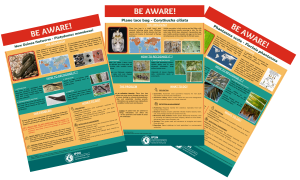
To download the Organism Alert posters go to:
Posters
The IPSN, with the support of the initiative’s diagnostic experts, produces informative posters on plant pests and pathogens to help identify these organisms of global concern.
Each poster contains concise background information and diagnostic features, complemented by images to help identify the key symptoms of the featured organism. Additionally, accompanying factsheets (see below) provide more in-depth information accessible via a QR code.
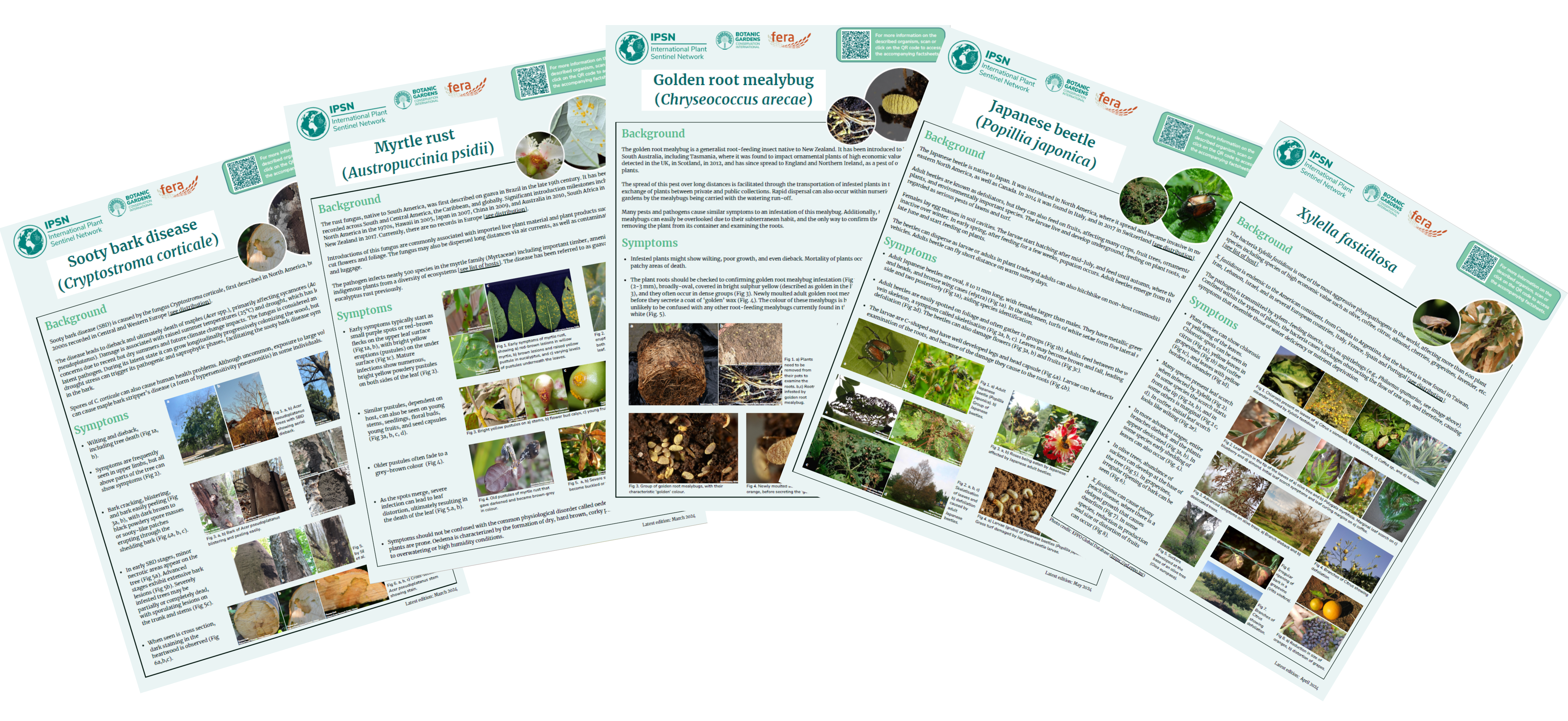
To learn more about our poster resources go to:
Factsheets
Complementing the posters, the IPSN has created comprehensive factsheets focused on plant pests and pathogens of global interest.
These factsheets provide in-depth information on the distribution, impact, dispersal, plant host species, and biology of the target organism, and supplementary resources for further exploration. For summarized symptoms information, accompanying posters can be accessed via a provided QR code.
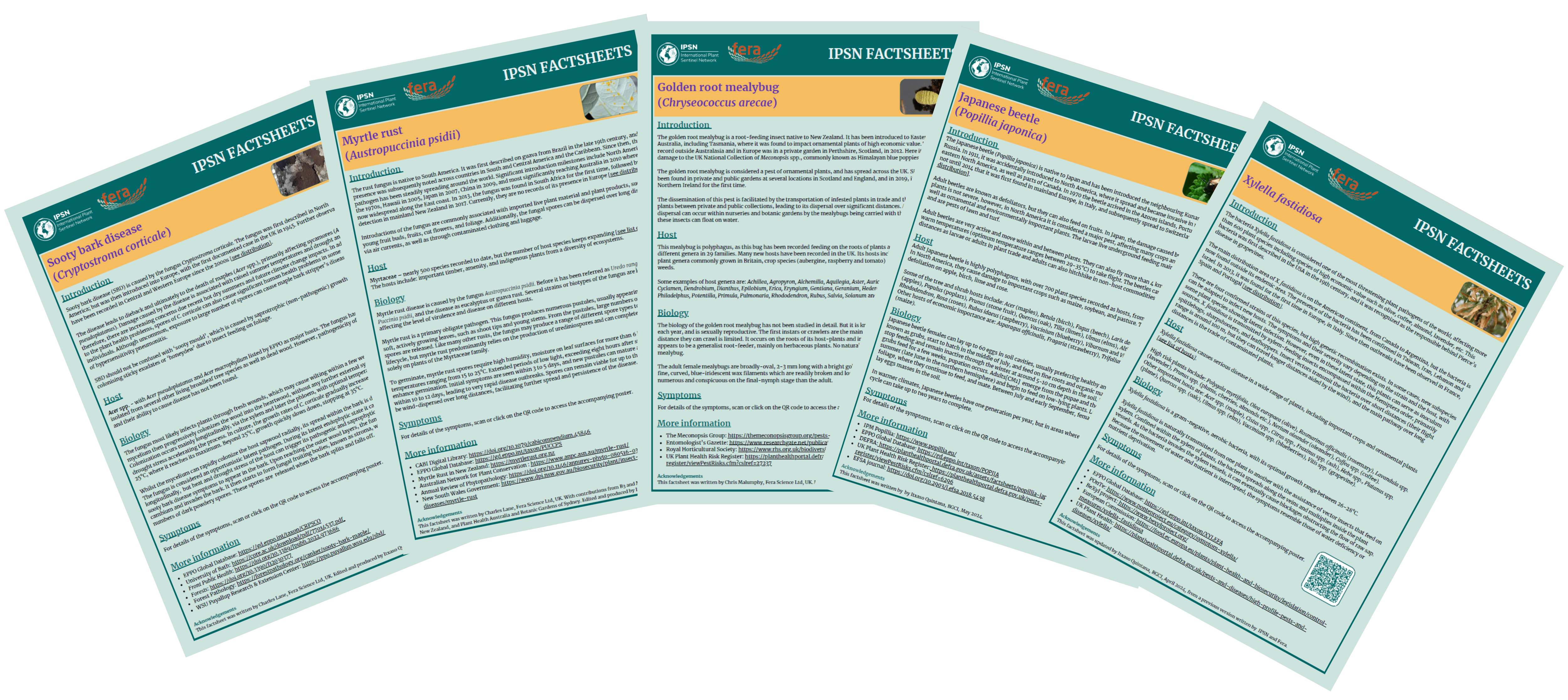
To learn more about our factsheets resources go to:
Survey forms
The IPSN has also designed survey forms for monitoring key target pests and pathogens of global concern.
These forms help gather information during the collections monitoring process, enabling the early detection of symptoms associated with the targeted pests and pathogens. By facilitating the identification of potential plant health issues, these survey forms play a crucial role in early diagnosis and the identification of appropriate management strategies.

To learn more about our survey forms go to:
Sampling protocols
The IPSN collaborates with various organizations and consortia to develop comprehensive sampling protocols as part of its diverse projects.
These protocols provide detailed, step-by-step guidance on collecting samples for diagnosing various target organisms. By standardizing the sampling process, these protocols support accurate and consistent practices, enhancing the effectiveness of diagnostic efforts, surveillance efforts and contributing to improved plant health management globally.
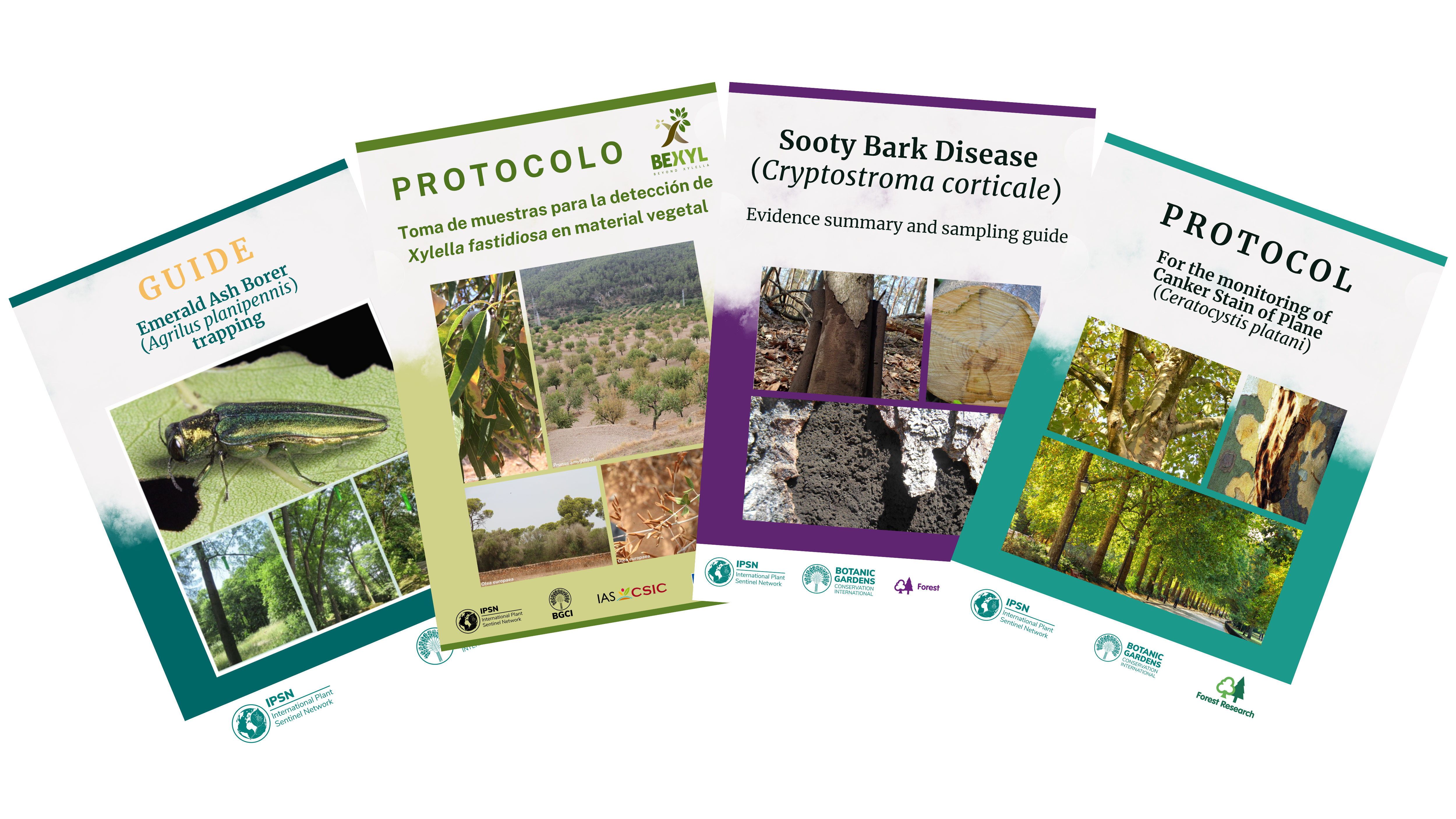
To explore these resources go to:
Manuals and Guides
The IPSN regularly produces invaluable manuals and guidelines aimed at supporting botanic garden staff in biosecurity and plant health monitoring activities.
These manuals encompass a diverse array of topics, including guides for monitoring and identifying plant damage as well as instructional videos and guidance for conducting sampling and photographing for diagnostics.
To explore our guidelines and manual resources go to:
Biosecurity information resources
The IPSN continues to design and develop a range of resources aimed at facilitating the implementation of biosecurity best practices within gardens.
Being through the creation of guidance resources or designing signage to promote best practices within staff and visitors we hope you will find these resources useful. Follow the link below to explore further:
IPSN Newsletters
Each quarter, the IPSN circulates a newsletter to keep members and partners informed and engaged, while fostering a sense of connection within our community.
In the newsletter, we highlight new resources on pest and disease monitoring and biosecurity, ongoing project progress, new initiatives, and upcoming events. We have also added a section for members to share their plant health efforts and biosecurity news.
IPSN Blogs
The IPSN Blogs are contributions from our members and partners, aimed at a general audience. Topics cover a wide range of plant health and biosecurity issues.
Publications
Over the years, the IPSN team and our members have produced publications on the work of the network, plant health and biosecurity best practices that have been published in scientific journals and magazines.
To access our repository, follow the link below:
Share
